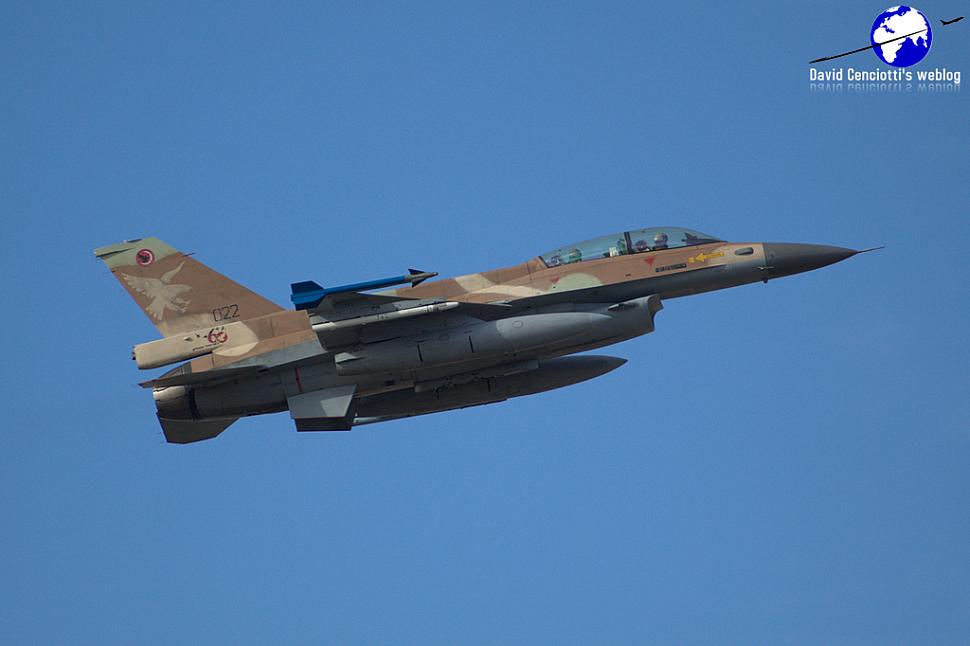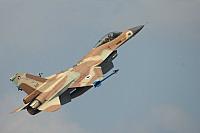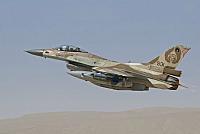Fighter Jet News
F-16 Fighting Falcon News
IDFAF continues to upgrade older F-16s as delivery of the F- 35 might be delayed
December 12, 2011 (by
Lieven Dewitte) -
Amid growing concern that delivery of the F-35 Joint Strike Fighter might be delayed, the Israel Air Force is further moving forward with a new upgrade program for its older F-16 fighter jets.

The decision to begin the upgrades on the F-16 C/D models – called "Barak" in the IAF – began in 2010 with the installation of new avionics and a new mission-debriefing system.
In an effort to increase the aircraft's lifespan, the IAF has now decided to also upgrade the F- 16s flight-control system (FCS). Successful test were performed using the FCS from the F-16I and now a decision was made to equip all F-16C/Ds with it.
Pilots of the Barak aircraft will also be equipped with Elbit's wide-angle conventional heads-up displays (WAC HUD) and sight helmet system, which enables pilots to aim their weapons simply by looking at their targets.
Elbit developed a new design that uses legacy optics but replaces the outmoded chassis, cathode ray tube and associated drive control electronics. The new display design reduces total part count and power consumption, the company said.
The Barak will also be fitted with new high-resolution screens aimed at further increasing the pilots' situational awareness.
The upgrades come amid the possibility the delivery of the F- 35 will be delayed.
In 2010, the Defense Ministry signed a $2.75 billion contract for its first squadron of 20 F-35s, which are supposed to begin arriving in 2015 with delivery completion in 2016. Pilots are to undergo training with the U.S. Air Force starting in 2014.
IAF commander Maj.-Gen. Ido Nehushtan recently held a number of discussions within the force regarding reports the Pentagon was considering slowing down the development of the F-35 after a number of cracks were discovered on some of the aircraft.
"I believe it's wise to sort of temper production for a while here, until we get some of these heavy years of learning under our belt and get that managed right,” Pentagon F-35 program director V.-Adm. David Venlet said last week.
The Defense Ministry has in the past claimed that Israeli procurement plans will not be affected by delays to the US program, but senior IDF officers said recently that additional delays could lead the IAF to consider purchasing new F-15s or F-16s to bridge the gap between now and when the aircraft arrives if it is pushed back later than 2017.
The Israeli Air Force paid close attention when Boeing launched the F-15SE in July 2010. The IDF/AF currently operates 25 customized F-15I Ra'am aircraft, and 101 F-16I Sufa jets that form its strategic spearhead and would be the squadrons deployed in any strike against Iran.

IDFAF F-16D block 30 #022 from tayeset 109 is taking off at Decimomannu AB during exercise VEX11 on October 27th, 2011. [Photo by Giovanni Maduli]
In an effort to increase the aircraft's lifespan, the IAF has now decided to also upgrade the F- 16s flight-control system (FCS). Successful test were performed using the FCS from the F-16I and now a decision was made to equip all F-16C/Ds with it.
Pilots of the Barak aircraft will also be equipped with Elbit's wide-angle conventional heads-up displays (WAC HUD) and sight helmet system, which enables pilots to aim their weapons simply by looking at their targets.
Elbit developed a new design that uses legacy optics but replaces the outmoded chassis, cathode ray tube and associated drive control electronics. The new display design reduces total part count and power consumption, the company said.
The Barak will also be fitted with new high-resolution screens aimed at further increasing the pilots' situational awareness.
The upgrades come amid the possibility the delivery of the F- 35 will be delayed.
In 2010, the Defense Ministry signed a $2.75 billion contract for its first squadron of 20 F-35s, which are supposed to begin arriving in 2015 with delivery completion in 2016. Pilots are to undergo training with the U.S. Air Force starting in 2014.
IAF commander Maj.-Gen. Ido Nehushtan recently held a number of discussions within the force regarding reports the Pentagon was considering slowing down the development of the F-35 after a number of cracks were discovered on some of the aircraft.
"I believe it's wise to sort of temper production for a while here, until we get some of these heavy years of learning under our belt and get that managed right,” Pentagon F-35 program director V.-Adm. David Venlet said last week.
The Defense Ministry has in the past claimed that Israeli procurement plans will not be affected by delays to the US program, but senior IDF officers said recently that additional delays could lead the IAF to consider purchasing new F-15s or F-16s to bridge the gap between now and when the aircraft arrives if it is pushed back later than 2017.
The Israeli Air Force paid close attention when Boeing launched the F-15SE in July 2010. The IDF/AF currently operates 25 customized F-15I Ra'am aircraft, and 101 F-16I Sufa jets that form its strategic spearhead and would be the squadrons deployed in any strike against Iran.
Additional images:
Related articles:
Forum discussion:
Tags
- ()
- IDFAF launches F-16C/D upgrade program (2009-05-12)
- Israel launches program to upgrade its F-16 fleet (2006-01-25)
- F-16 Fighting Falcon news archive
Forum discussion:
- Start a discussion about this article in the F-16.net forum.
Tags



